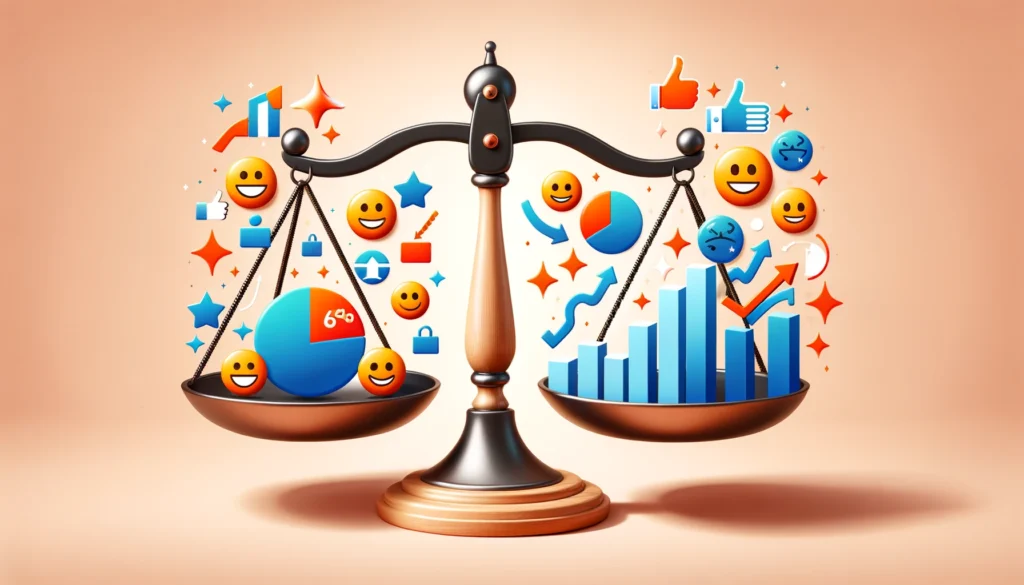Good CX Makes 75% Of Customers Spend More.
Using metrics, you can enhance your procedures to better meet your customers’ needs. Resolving issues quickly increases the likelihood of a consumer sticking with your firm by 2.4 times. If your products and services are straightforward and easy to use, you can reduce the customer effort score (CES) and increase brand loyalty by 76%.
Retaining consumers is easier and cheaper for a firm than seeking new ones, and positive customer experiences can lead to repeat business. Remembering that, let’s examine the most important metrics for measuring customer experience.
What Is Customer Experience?
An individual’s or a potential client’s “customer experience” (CX) is the sum of all their encounters with a company. This begins when a customer learns about a company and continues throughout the buying process. Customer experience also encompasses the time after purchase, whether a few weeks, months or even years.
Despite a company’s best efforts, it is necessary to take a step back and assess the whole picture before purchasing. This can necessitate continuing to assist clients for an extended period.
Why is the company making an additional investment of time and money? A whopping 32% of consumers worldwide would abandon a beloved brand after a single negative encounter, and acquiring new customers is more expensive than keeping old ones.

What Are The Advantages Of Successful Cx Measurement?
According to the research that has been carried out in this area, some of the main advantages of accurate CX measurement are:
- Raised Levels of Customer Contentment
- Loyalty and retention of customers are enhanced.
- Recommendations and Positive Word of Mouth
- Greater CLV (Customer Lifetime Value)
- An Edge over the Competition
- Making Well-Informed Decisions, Creating New Value, and Standing Out
- Efficient Distribution of Assets
- Enhanced Staff Participation Meeting Client Needs
- Saved Money
- Reducing Danger
- A More Reputable Name
- Customer-Focused Work Environment
- Ensure the Long-Term Viability of Your Company
Best Ways of Measuring Customer Experience
Customer experience metrics may and should be used in conjunction with one another to provide a fuller picture of the customer’s journey with your brand. Based on your business model, there are many customer experience metrics to track, some of which may be more crucial than others. However, the indicators provided below are essential for every industry.

1. Net Promoter Score(NPS)
Due to its clarity and ease of use, the Net Promoter Score has become one of the most popular metrics. Since its formal launch in 2003, millions of brands—including two-thirds of Fortune 1000 companies—have employed the Net Promoter Score, a business tool for analyzing customer experience developed in 2001.
A client is assumed to be a promoter in NPS. How inclined are you to suggest this brand to someone you know? The consumer rates the likelihood of an event using a numerical value from 0 (very unlikely) to 10 (very likely).
These categories are used to classify the clients according to their scores:
- Detractors (0 to 6): Those who aren’t on board with the brand and can disseminate their negativity to others are known as detractors, and their numbers range from zero to six.
- Passives (7 to 8): These customers are content with the brand overall but won’t recommend it. Competing firms with superior items or more enticing deals will likely sway them.
- Promoters (9 to 10): Scored between 9 and 10, “promoters” are brand advocates who buy into the company’s values and rally others to do the same.
To find your Net Promoter Score (NPS),
Subtract Your Promoters And Detractors
There is a range from a perfect score of 100 to a minimum of -100. The computation is uncomplicated and has only one dimension. Complementing this measure with other CX metrics will make it more helpful.
2. Customer Satisfaction Score (CSAT).
One of the simplest ways to measure your client experience is with the client Satisfaction Score (CSAT). As support interactions are a big part of CX, CSAT can offer you a sense of the customer experience, even if it is usually employed as a metric for customer service. To determine the level of satisfaction a customer feels after interacting with your company, we have designed this straightforward poll.
For instance, following a live chat with a support agent, customers can rate the agent’s response according to the level of satisfaction or helpfulness of the solutions provided. Alternative: inquire about customer satisfaction after they have made a transaction.
How to Calculate CSAT:
All it takes to determine CSAT is to send out a survey right after a transaction or interaction. Using a similar scale, this survey will determine the satisfaction level the client feels they have had with their experience. The average score of that survey is the CSAT.

3. Customer Effort Score(CES)
Customers desire simple encounters. Your website’s navigation needs to be intuitive. Your goods have to be user-friendly and simple to put together. The client should have no trouble contacting your customer service team.
A Customer Effort Score (CES) survey is a great tool for gathering customer feedback about the ease, neutrality, or difficulty of their experiences with a company’s products or services.
How to Calculate CES:
Customer effort score (CES) is determined by dividing the total number of survey replies by the sum of all customer effort assessments.
If consumers are giving a product low ratings because of its difficulty, you should think of new ways to make it easier to use. To improve the user experience, you might install a more straightforward template or rethink the site’s layout if the menu is difficult to locate.
4. Customer Lifetime Value(CLV)
The amount of money a client has made for a company over the course of their relationship is known as their customer lifetime value (CLV) or their “worth” to a company. A company’s expenditure on client retention is also factored into the equation.
It’s a useful indicator of customer satisfaction since it shows whether customers are happy and spend more or less money with your company.
How to Calculate CLV:
Customers’ lifetime value (CLV) is determined by multiplying customer value by the average customer’s longevity. The CLV is usually higher when the CX is better. However, if you notice that the consumer is gradually spending less, you may be able to figure out why and devise ways to increase the CLV.
5. Customer Retention Rate
Churn is the polar opposite of customer retention. This metric measures the percentage of current customers who maintain their spending on the brand throughout a specific time frame.
It is more profitable for organizations to retain customers than to acquire new ones. Thus, brands must understand customer loyalty and what keeps customers returning.
The retention rate must be computed first. The retention rate is calculated by combining customer count at the beginning, end, and new customer count over a certain time period (e.g., a week, month, or year).
To make your customers happy and keep them coming back, you must track more than client retention.

6. Customer Churn Rate
Your churn rate is the proportion of your user base deciding not to continue using your service after a specific amount of time. Although employee turnover is unavoidable, it is critical to identify the causes of it in order to mitigate it as much as possible.
How to Calculate the Churn Rate:
To determine your churn rate, choose a time frame and add up all the customers who have joined and those who have left within that timeframe.
Next, divide the number of customers who churned by the total number of customers gained to find your churn rate. Then, multiply that decimal by 100%.
This measure helps you understand why customers are defecting. Could it be due to insufficient participation, a problematic user journey, or not enough help? You can find out how to lower your churn rate by tracking and analyzing it.
Conclusion
In today’s experience economy, the key to long-term success is an approach that prioritizes people and shows empathy.
The first step in listening to and comprehending your customers is to enhance your method of measuring client experience. This is the foundation of trust and loyalty.
In response to the challenges and opportunities posed by emerging technology, CX executives are refining their methods for measuring customer experience. Align your departmental and company key performance indicators and success metrics with your customers’ priorities and goals.
Adopting a journey-based strategy for measuring customer experience may improve your capacity to find and fix problems for each customer, help you reach your business goals, and provide the frictionless experiences your consumers want.







